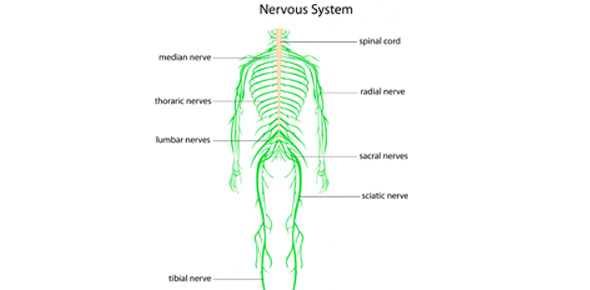A & P III Nervous System

A & P III Nervous System is a quiz designed to test and advance your knowledge on the Central Nervous System. How good are you with the CNS? Take up the challenge below and see how good you are.
- 1.
The two functions of the nervous system are
- A.
Stimulate movement
- B.
Provide better cellular respiration
- C.
Maintain homeostatis
- D.
Cause atrial depolarization
Correct Answer(s)
A. Stimulate movement
C. Maintain homeostatisExplanation
The nervous system has two main functions: stimulating movement and maintaining homeostasis. Stimulating movement refers to the ability of the nervous system to send signals to muscles, allowing them to contract and produce movement. This function is essential for activities such as walking, talking, and even breathing. Maintaining homeostasis involves regulating and balancing the body's internal environment, such as body temperature, blood pressure, and pH levels. The nervous system helps to coordinate and control various bodily functions to ensure that they remain within a stable range.Rate this question:
-
- 2.
Name the two parts of the Central Nervous System (CNS)
Correct Answer(s)
Brain Spinal CordExplanation
The Central Nervous System (CNS) consists of two main parts: the brain and the spinal cord. The brain is responsible for processing information, controlling body functions, and coordinating actions. It is located in the skull and is protected by the skull bones. The spinal cord is a long, thin bundle of nerves that extends from the brain down through the spinal column. It acts as a communication pathway between the brain and the rest of the body, transmitting signals to and from the brain. Together, the brain and spinal cord form the central control center of the nervous system.Rate this question:
- 3.
Name the two main divisions of the nervous system
- A.
Somatic Nervous System
- B.
Central Nervous System
- C.
Autonomic Nervous System
- D.
Peripheral Nervous System
Correct Answer(s)
B. Central Nervous System
D. Peripheral Nervous SystemExplanation
The two main divisions of the nervous system are the central nervous system and the peripheral nervous system. The central nervous system consists of the brain and spinal cord, which are responsible for processing and coordinating information. The peripheral nervous system includes all the nerves outside of the central nervous system, which transmit information between the central nervous system and the rest of the body.Rate this question:
-
- 4.
The nerve cells that convey information from receptors in the body to the CNS. Also called sensory neurons.
- A.
Efferent
- B.
Neurons
- C.
Neuroglia
- D.
Afferent
Correct Answer
D. AfferentExplanation
Afferent neurons, also known as sensory neurons, are responsible for transmitting information from receptors in the body to the central nervous system (CNS). These neurons play a crucial role in the sensory process, allowing us to perceive and interpret various stimuli from our environment. Unlike efferent neurons, which transmit signals from the CNS to the rest of the body, afferent neurons are specifically involved in relaying sensory information to the brain and spinal cord for processing and response. Neuroglia, on the other hand, are non-neuronal cells that provide support and protection to neurons in the nervous system.Rate this question:
-
- 5.
Conveys information from CNS to muscles and glands. Also called sensory neurons.
- A.
Efferent
- B.
Neurons
- C.
Neuroglia
- D.
Afferent
Correct Answer
A. EfferentExplanation
Efferent neurons are responsible for conveying information from the central nervous system (CNS) to muscles and glands. They transmit signals that control muscle movement and activate glands to release hormones or other substances. These neurons are also known as motor neurons. Afferent neurons, on the other hand, transmit sensory information from the body to the CNS. Neuroglia refers to the supportive cells in the nervous system that provide structure and support for neurons.Rate this question:
-
- 6.
This system has efferent neurons that conduct impulses from CNS to skeletal muscles or voluntary muscles.
- A.
Peripheral
- B.
Autonomic
- C.
Somatic
- D.
Central
Correct Answer
C. SomaticExplanation
The correct answer is somatic because the question is asking for the system that has efferent neurons that conduct impulses from the central nervous system (CNS) to skeletal muscles or voluntary muscles. The somatic nervous system is responsible for voluntary movement and controls the skeletal muscles, allowing us to consciously control our body movements.Rate this question:
-
- 7.
This system is made up of efferent neurons that convey impulses from CNS to smooth muscle tissue, cariac muscles and glands.
- A.
Peripheral
- B.
Autonomic
- C.
Somatic
- D.
Central
Correct Answer
B. AutonomicExplanation
The correct answer is Autonomic. The autonomic nervous system is responsible for regulating involuntary bodily functions. It is made up of efferent neurons that transmit signals from the central nervous system to smooth muscle tissue, cardiac muscles, and glands. This system controls processes such as heart rate, digestion, and glandular secretion.Rate this question:
-
Quiz Review Timeline +
Our quizzes are rigorously reviewed, monitored and continuously updated by our expert board to maintain accuracy, relevance, and timeliness.
-
Current Version
-
Mar 20, 2023Quiz Edited by
ProProfs Editorial Team -
Oct 11, 2008Quiz Created by
Muddy19
 Back to top
Back to top


